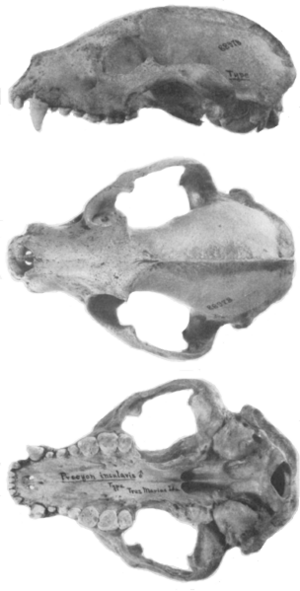Tres Marias raccoon facts for kids
Quick facts for kids Procyon lotor insularis |
|
|---|---|
 |
|
| Scientific classification |
|
| Kingdom: | Animalia |
| Phylum: | Chordata |
| Class: | Mammalia |
| Order: | Carnivora |
| Family: | Procyonidae |
| Genus: | Procyon |
| Species: | |
| Subspecies: |
P. l. insularis
|
| Trinomial name | |
| Procyon lotor insularis (Merriam, 1898)
|
|
The Tres Marias raccoon (Procyon lotor insularis) is a special type of common raccoon. It lives only on the two main islands of the Islas Marías. These islands are located off the western coast of Mexico, near the state of Nayarit.
Even though some scientists once thought it was its own species, it is now seen as a subspecies of the common raccoon. This means it's a unique group within the common raccoon family. It's a bit bigger than the raccoons you might know. It also has a special angular (sharp-cornered) skull. There are fewer than 250 adult Tres Marias raccoons left. People on the islands sometimes hunt them. Because of this, the International Union for Conservation of Nature says they are an "endangered" animal.
Contents
What is the Tres Marias Raccoon?
The Tres Marias raccoon is a unique kind of raccoon. It is a subspecies of the common raccoon. This means it is very similar to other common raccoons. But it has some small differences because it lives on islands.
How Scientists Classify This Raccoon
In 1898, a scientist named Clinton Hart Merriam first described this raccoon. He called it a subspecies of the common raccoon. Later, in 1950, Edward Alphonso Goldman thought it was a separate species. Many scientists agreed with him for a long time.
However, in 2005, two scientists, Kristofer M. Helgen and Don E. Wilson, studied some raccoon specimens. They found that the Tres Marias raccoon is different from the mainland Mexican raccoon. But these differences were not big enough to make it a completely separate species.
So, scientists now believe the Tres Marias raccoon was brought to the Islas Marías not too long ago. It then developed some unique traits. Because of this, it is now officially listed as a subspecies of the common raccoon.
Physical Features of the Tres Marias Raccoon
The Tres Marias raccoon is known for being a bit larger than other common raccoons. This is interesting because island animals often become smaller. This is called insular dwarfism, but it did not happen here.
Size and Appearance
In 1898, a scientist measured five adult male raccoons. Their average body length, including the tail, was about 84.1 cm (33.1 in). More recent measurements in 2005 showed they were between 84.0 and 90.4 cm (33.1 and 35.6 in) long.
Their fur is pale and short. On their bellies, there are only a few stiff outer hairs. These hairs cover the lighter brown undercoat.
Unique Skull and Teeth
One of the most special things about the Tres Marias raccoon is its angular skull. This means its skull has a more sharp, defined shape. It also has narrow molar teeth. These teeth are different from those of raccoons found further north.
Protecting the Tres Marias Raccoon
The Tres Marias raccoon is in danger. In 1996, the IUCN listed it as an endangered animal. This is because there are fewer than 250 adult raccoons left in the wild.
Threats to Their Survival
Another subspecies of raccoon, Procyon insularis vicinus, used to live on María Magdalena island. Sadly, it is now thought to be extinct. Scientists may never know if it was truly different from the Tres Marias raccoon.
The Tres Marias raccoon is sometimes hunted by people living on the islands. Not enough has been done to protect these raccoons from becoming extinct. Because they live in such a small area, there probably were never many of them. This is similar to other island raccoons, like the Cozumel raccoon and the extinct Barbados raccoon.

